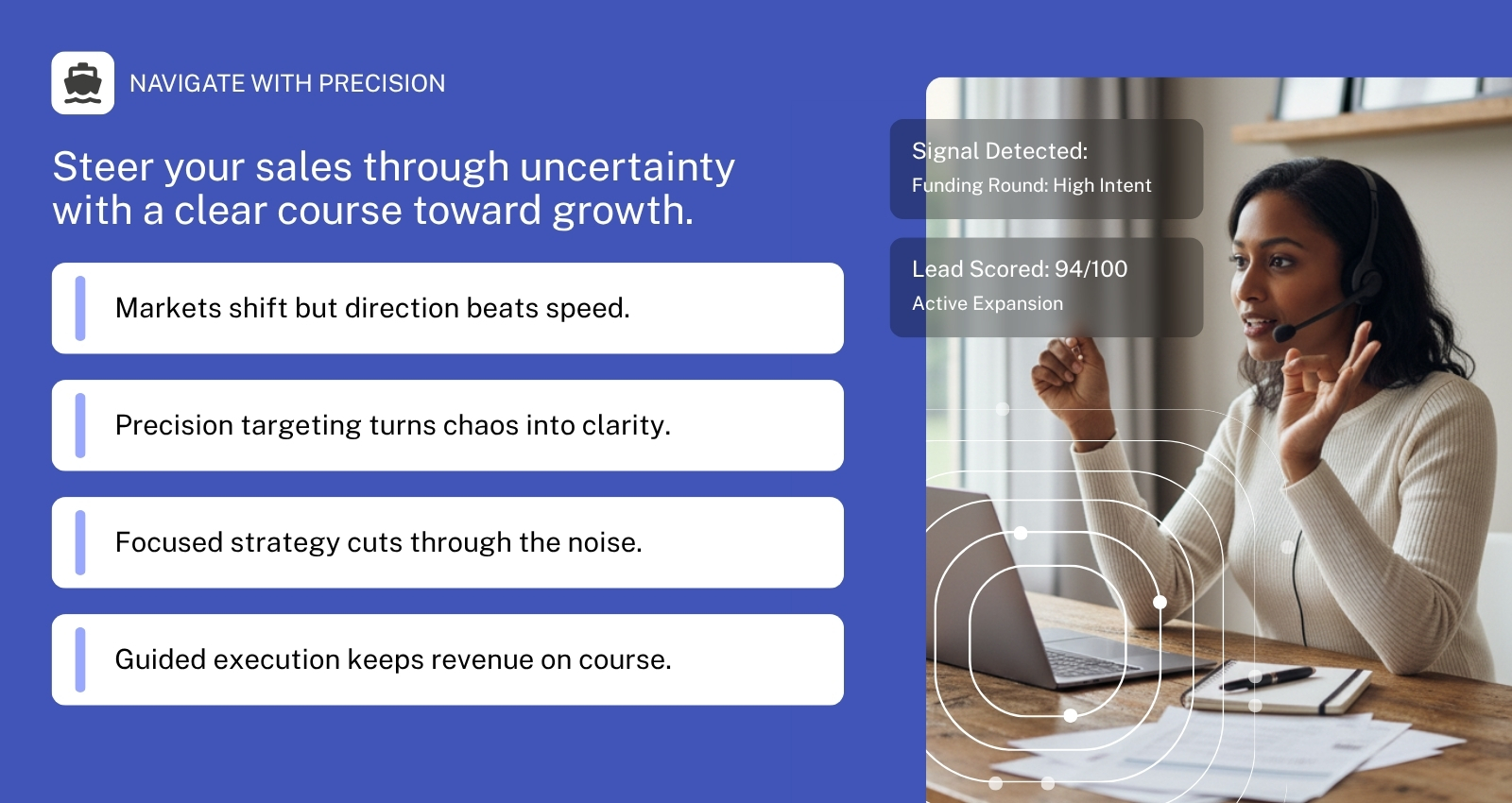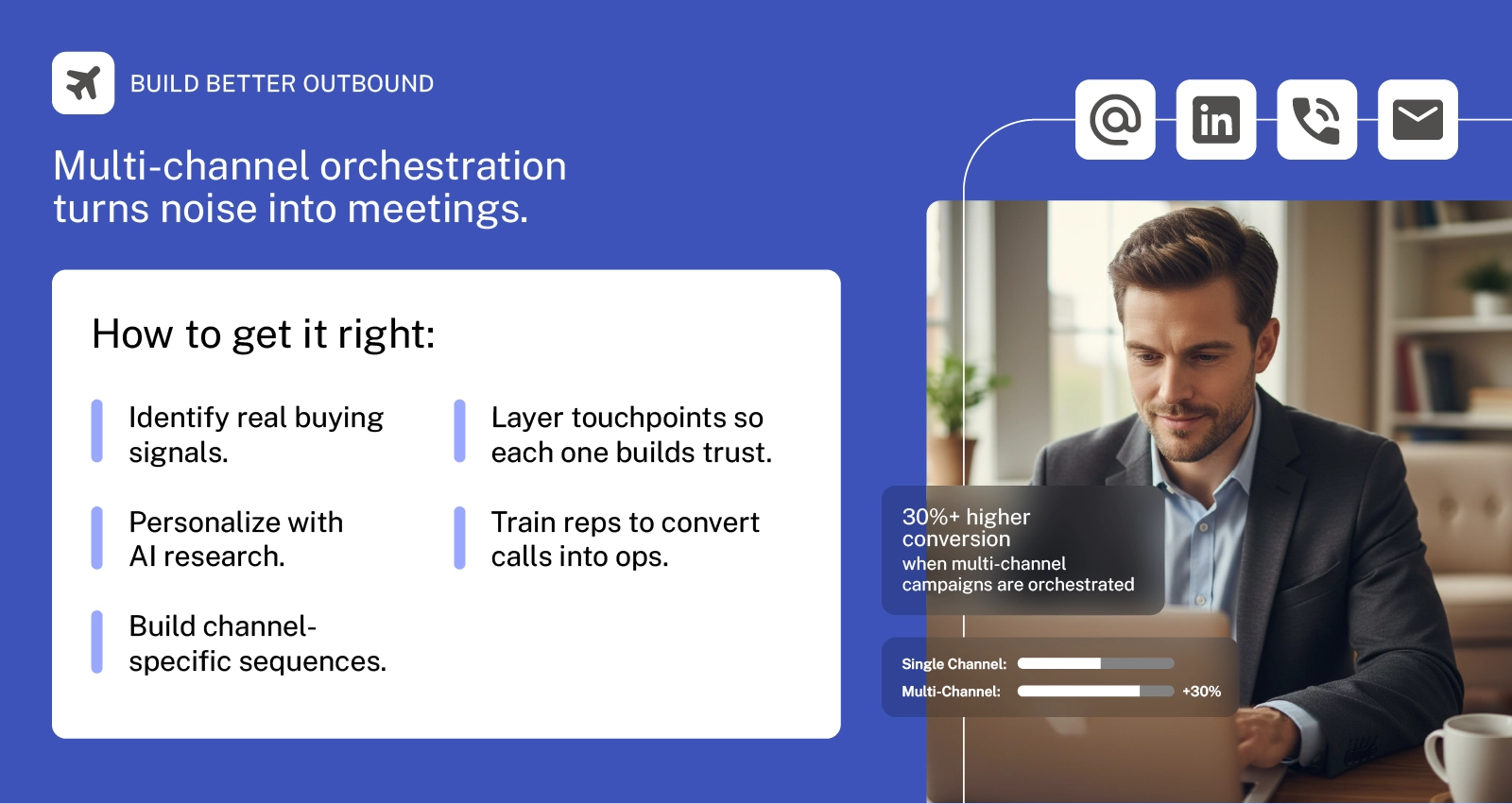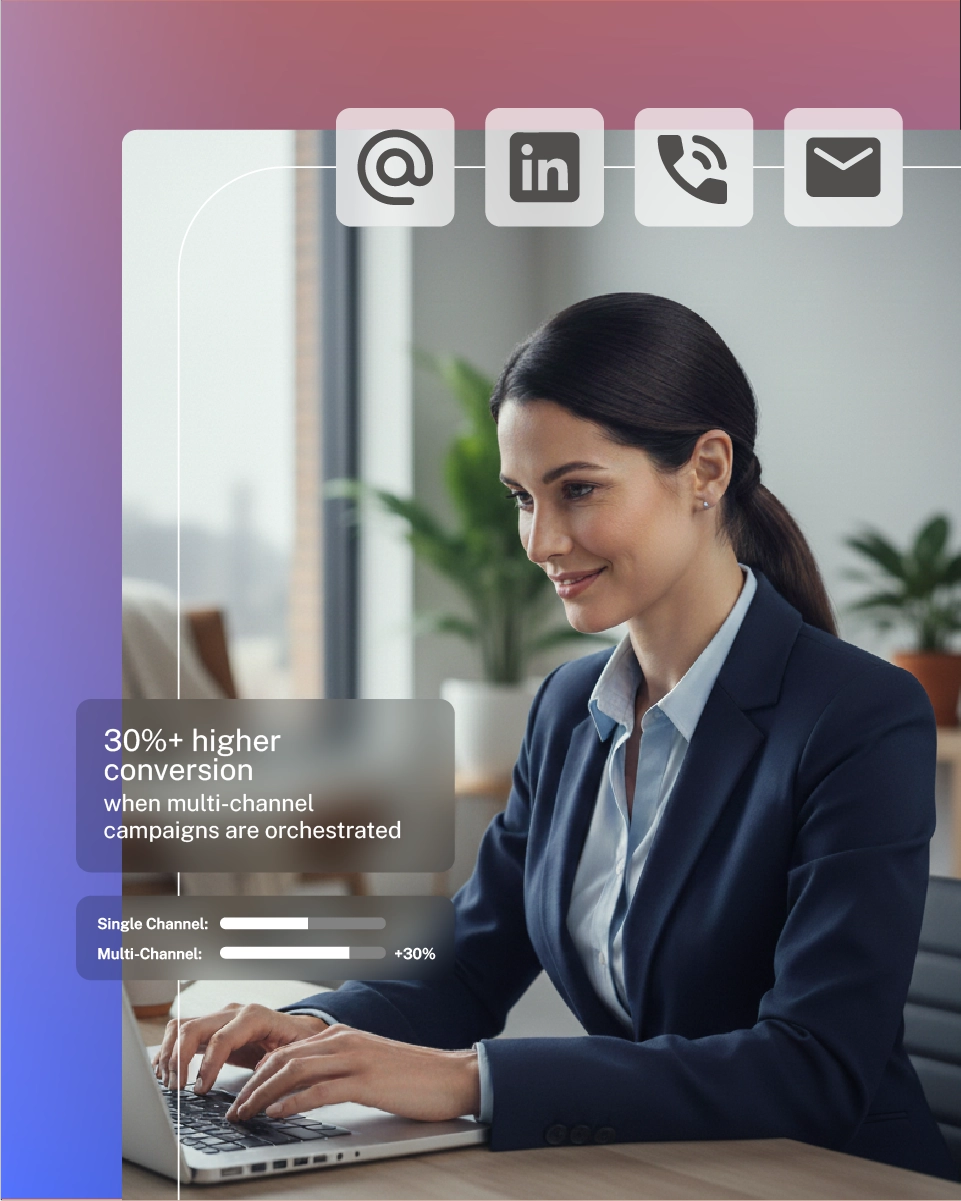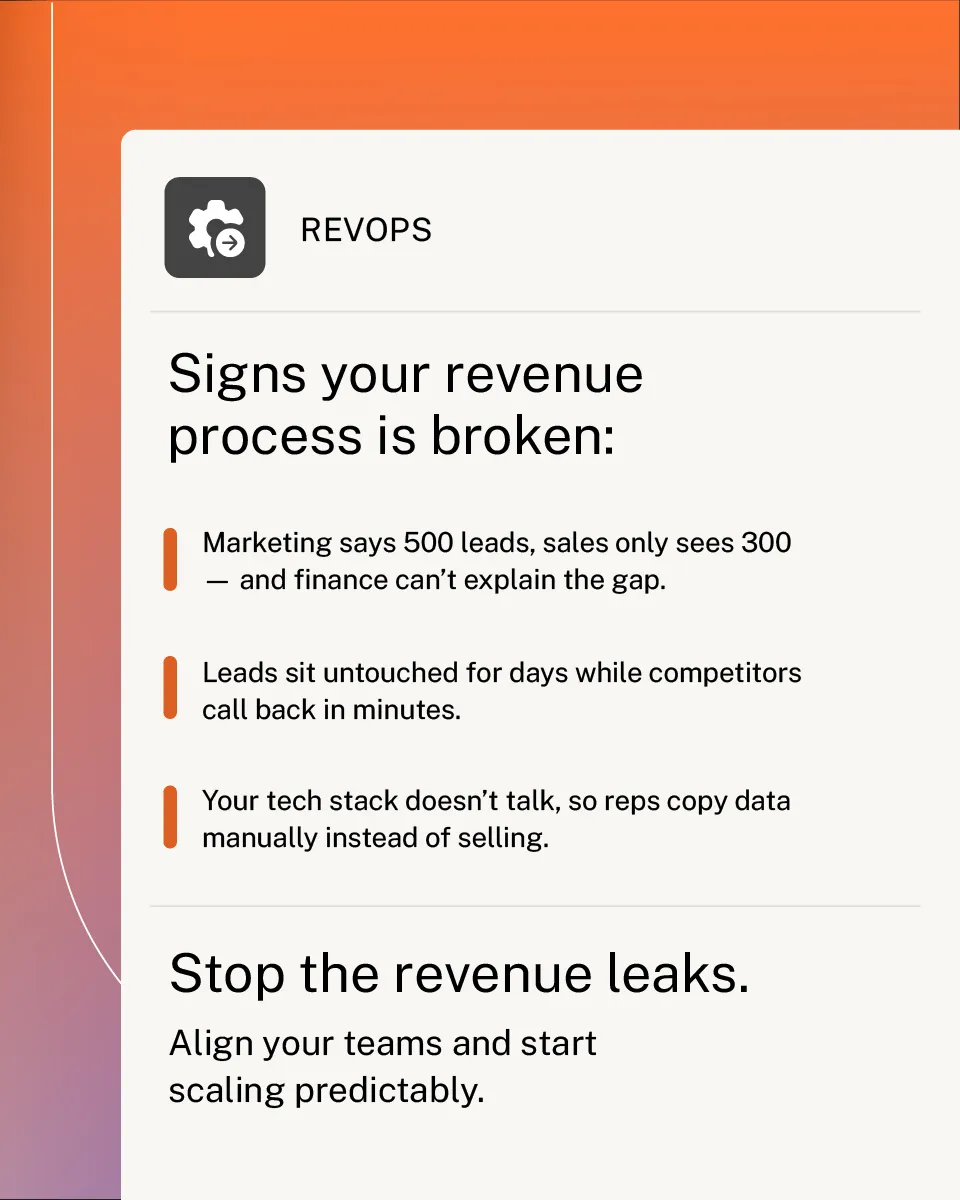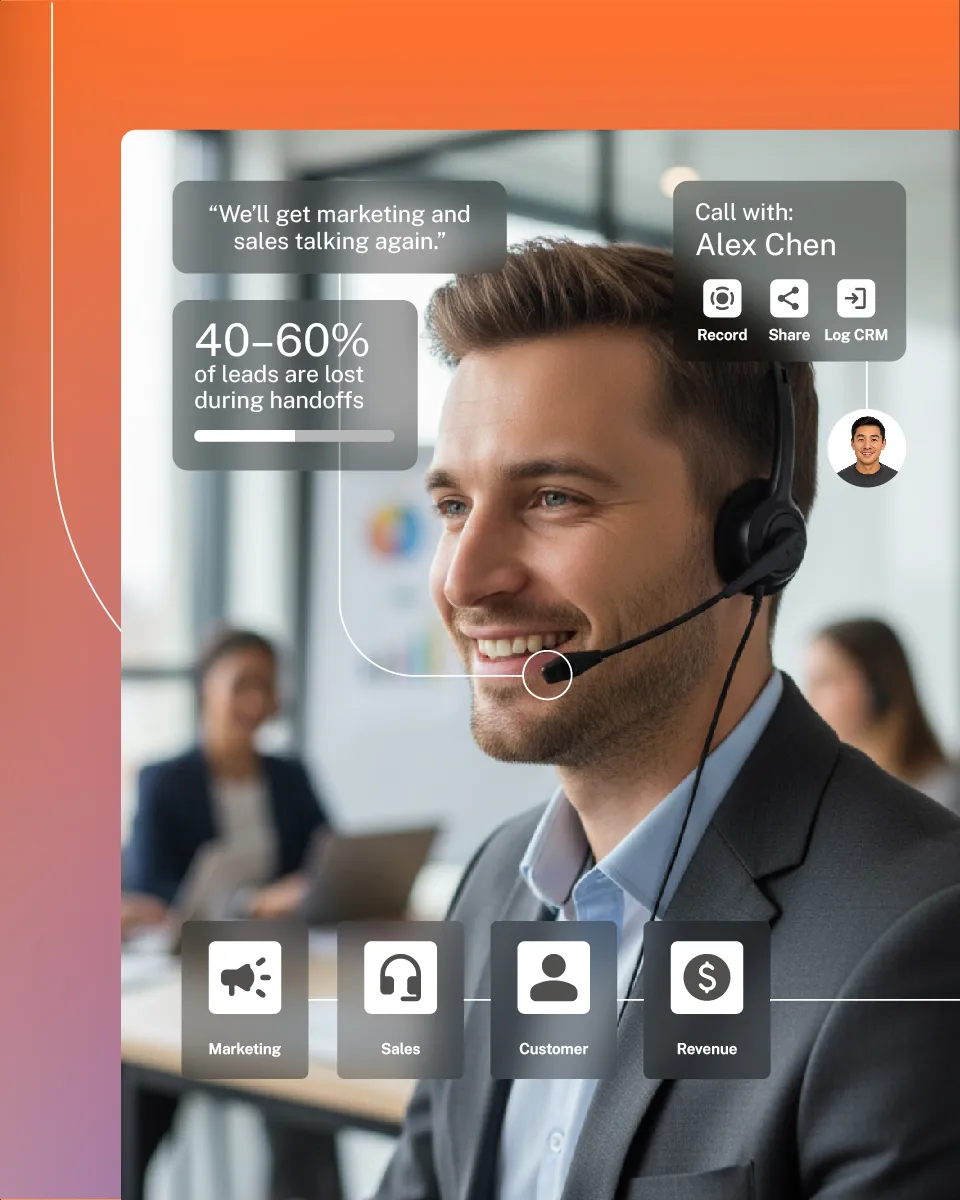

The Signal Revolution
"I'm drowning in signals," our one business development rep said to me the other day, scrolling through approximately 47 different notifications from various tools. "HubSpot says Company A downloaded a whitepaper. ZoomInfo alerts tell me Company B hired someone new. LinkedIn tells me Company C posted about their challenges. But I have no bloody idea who actually cares or what to do with any of it."
He paused, looking genuinely defeated. "It's like having a smoke detector that goes off every time someone makes toast. Eventually, you just ignore it."
That conversation stuck with me because Graham isn't alone. According to recent research, 73% of marketing-qualified leads never convert to opportunities, and 27% of sales reps say they can't effectively act on the intent data their marketing teams provide.
The Intent Data Paradox: Why More Information is Making Us Less Effective
We're living in the golden age of buyer intelligence, yet most sales teams are more confused than ever.
Think about it. Your average B2B sales rep has access to:
- Website visitor tracking
- Content consumption analytics
- Social media monitoring
- Technographic changes
- Job change alerts
- Funding announcements
- Buying signals from multiple sources
But here's what actually happens: Sarah from Company X downloads your eBook about "Cloud Security Best Practices." Your intent data platform flags Company X as "high intent." Your SDR reaches out to the first contact they find and sends a generic email about cloud security solutions.
Plot twist: Sarah's an intern who was doing research for her manager's presentation. The actual decision-maker (who never touched your content) gets a completely irrelevant outreach message and promptly hits delete.
This is why intent data has become the emperor's new clothes of B2B sales. Everyone talks about how revolutionary it is, but deep down, we all know something's missing.
Contact-Level Intent: The Missing Piece of the ABM Puzzle
What if I told you there's a way to know not just that someone at Company X is interested in cloud security, but that David Thompson, their CISO, spent 12 minutes reading an article about zero-trust architecture on a competitor's blog this morning?
That's the power of contact-level intent data. And it's exactly what our partners at Influ2 just cracked with their new Audienscope feature.
Why Account-Level Intent is Like Ordering Pizza for a Wedding
Traditional intent data tells you "someone at this company is hungry." Contact-level intent tells you "David in accounting wants pepperoni, Sarah in HR is vegetarian, and the CEO is doing keto."
Which one helps you actually deliver value?
The difference is profound. When Gong analyzed over 500,000 sales calls, they found that personalized outreach based on individual buyer behavior resulted in 40% higher response rates compared to account-level targeting.
But most tools can't tell you which specific person showed the intent. Until now.
The Three Types of Contact-Level Intent That Change Everything
Influ2's Audienscope introduces three game-changing signal types that go way beyond traditional "they visited your pricing page" alerts:
1. Search Intent (The Zero-Click Revolution)
Remember when a Google search meant clicking through to websites?
With AI-powered search summaries and featured snippets, 65% of searches now end without a click. Traditional intent data misses this entirely because it relies on website visits that aren't happening.
But what if you could know when your exact target buyer searched for "enterprise data backup solutions" this morning, even if they never clicked on your site?
That's search intent detection. And it's bloody brilliant.
I can already picture the outreach: "Hi David, I noticed you might be researching enterprise backup solutions. Most CTOs tell us their biggest concern isn't just data protection, but recovery speed during critical incidents. Would you be open to a quick conversation about how companies like yours are achieving 99.9% recovery time objectives?"
2. Third-Party Content Engagement
Here's something that'll make you question everything: 67% of B2B buyers consume competitor content during their research process.
Your perfect prospect might be religiously reading your competitor's blog, attending their webinars, and downloading their guides. Traditional intent data? Completely blind to this.
But contact-level intent can detect when Sarah Johnson, VP of Operations at Target Company, just spent 15 minutes reading an article about "Digital Transformation Challenges in Manufacturing" on your competitor's site.
This is gold. Pure gold.
Instead of generic outreach, you can reference the exact content they engaged with and provide additional value: "Hi Sarah, I saw you're researching digital transformation challenges in manufacturing. That particular article missed a crucial point about legacy system integration that we've seen trip up 80% of manufacturing companies. Would you be interested in a brief case study showing how similar companies navigated this?"
3. Social Media Signals
LinkedIn has become the wild west of business content. Everyone's posting, sharing, and commenting on everything. The noise is deafening.
But what if you could filter through all that noise and only surface when your target buyers post about topics directly relevant to your solution?
When your prospect posts "Struggling with data silos between our CRM and marketing automation platform" – that's not noise. That's a buying signal wrapped in a bow with your name on it.
Signal Center: Making Intelligence Actually Actionable
Now, having better signals is only half the battle. The other half is making them actionable for your sales team without adding another tool to their already bloated tech stack.
This is where Signal Center comes in, and it addresses something that's been driving revenue operations managers to drink heavily: signal fatigue.
The AI Context Revolution
Instead of receiving an alert that says "Jamie clicked on an ad," you get "Jamie is researching marketing attribution solutions based on her engagement with content about multi-touch attribution models."
See the difference? One's a data point. The other's actionable intelligence.
Buying Group Visibility
B2B decisions involve an average of 6.8 stakeholders. Yet most intent data treats each signal as isolated events.
Signal Center automatically groups related signals by account and buying group. So instead of seeing:
- "David viewed pricing page"
- "Sarah downloaded ROI calculator"
- "Michael attended webinar"
You see: "3 stakeholders from Target Company are actively researching solutions, with David (decision-maker) focusing on pricing, Sarah (influencer) calculating ROI, and Michael (user) learning about implementation."
That's the kind of intelligence that closes deals.
No Workflow Disruption
Here's my favorite part: your sales team doesn't need to log into another platform. Signals can be delivered through Slack, email digests, or directly in Salesforce.
Because let's be honest, if your solution requires sales reps to change their behavior significantly, it's DOA. (Looking at you, every "revolutionary" CRM that died a quiet death in the 2010s.)
Why This Matters for Your Sales Development Strategy
If you've been following our previous posts about measuring outbound success beyond traditional metrics, you know we're big believers in awareness-driven approaches over activity-driven ones.
Contact-level intent data is the ultimate awareness amplifier.
Precision Targeting at Scale
Remember the old days of buying lists and hoping for the best? (Please tell me you're not still doing that.)
With contact-level intent, your SDR can reach out to exactly the right person, at exactly the right time, with exactly the right message. It's precision targeting without the manual research that kills productivity.
Pattern Interrupt Mastery
We've written extensively about pattern interrupts and why they're crucial for breaking through the noise.
Contact-level intent gives you the ultimate pattern interrupt: relevant personalization based on actual behavior.
Instead of "I noticed you work in manufacturing..." you can lead with "I noticed you were researching legacy system integration challenges..."
One's generic. The other stops the scroll.
Sales Velocity Acceleration
When your outreach is based on real buying behavior rather than cold assumptions, everything accelerates:
- Higher response rates (because relevance wins)
- Shorter qualification cycles (because intent indicates need)
- Better meeting quality (because you're talking to engaged prospects)
- Faster deal progression (because timing is everything)
The Zero-Click Search Reality
Here's a stat that should terrify every marketer: Google's "zero-click" searches (where users get their answer without visiting a website) now account for 65% of all searches.
Your prospects are researching solutions, comparing options, and forming opinions without ever visiting your website. Traditional intent data based on website visitors is missing the majority of research behavior.
But search intent detection captures this invisible research activity. It's like having X-ray vision into your prospect's information gathering process.
The Compound Effect of Better Signals
When you combine contact-level intent data with your existing sales development efforts, the results compound:
Your multi-channel outreach becomes hyper-relevant. Your qualification frameworks become more efficient. Your pipeline becomes more predictable.
It's not about working harder. It's about working with better intelligence.
The Future of Sales Development is Signal-Driven
Look, I've been in this industry long enough to see plenty of "revolutionary" technologies that were anything but revolutionary.
But contact-level intent data? This feels different. This feels like one of those rare innovations that actually changes how we work fundamentally.
Because at the end of the day, sales is about having the right conversation with the right person at the right time. Contact-level intent data gives you all three.
Your prospects are already telling you what they need. They're researching solutions, engaging with content, and sharing challenges on social media.
The question isn't whether they're showing intent. The question is whether you're smart enough to listen.
What This Means for Your 2026 Strategy
If you're planning your sales development strategy for next year, contact-level intent data should be at the center of it.
Not because it's the latest shiny object (though it is pretty shiny). But because it solves real problems that have been plaguing sales teams for years:
- How to identify active buyers before they reach out
- How to personalize outreach without manual research
- How to time conversations for maximum impact
- How to focus efforts on prospects most likely to convert
The companies that figure this out first will have an unfair advantage. The companies that don't? Well, they'll be stuck with the old playbook while their competitors eat their lunch.





“My priority is ensuring we have the right strategy and culture in place to achieve the company vision”
"I'm drowning in signals," our one business development rep said to me the other day, scrolling through approximately 47 different notifications from various tools. "HubSpot says Company A downloaded a whitepaper. ZoomInfo alerts tell me Company B hired someone new. LinkedIn tells me Company C posted about their challenges. But I have no bloody idea who actually cares or what to do with any of it."
He paused, looking genuinely defeated. "It's like having a smoke detector that goes off every time someone makes toast. Eventually, you just ignore it."
That conversation stuck with me because Graham isn't alone. According to recent research, 73% of marketing-qualified leads never convert to opportunities, and 27% of sales reps say they can't effectively act on the intent data their marketing teams provide.
The Intent Data Paradox: Why More Information is Making Us Less Effective
We're living in the golden age of buyer intelligence, yet most sales teams are more confused than ever.
Think about it. Your average B2B sales rep has access to:
- Website visitor tracking
- Content consumption analytics
- Social media monitoring
- Technographic changes
- Job change alerts
- Funding announcements
- Buying signals from multiple sources
But here's what actually happens: Sarah from Company X downloads your eBook about "Cloud Security Best Practices." Your intent data platform flags Company X as "high intent." Your SDR reaches out to the first contact they find and sends a generic email about cloud security solutions.
Plot twist: Sarah's an intern who was doing research for her manager's presentation. The actual decision-maker (who never touched your content) gets a completely irrelevant outreach message and promptly hits delete.
This is why intent data has become the emperor's new clothes of B2B sales. Everyone talks about how revolutionary it is, but deep down, we all know something's missing.
Contact-Level Intent: The Missing Piece of the ABM Puzzle
What if I told you there's a way to know not just that someone at Company X is interested in cloud security, but that David Thompson, their CISO, spent 12 minutes reading an article about zero-trust architecture on a competitor's blog this morning?
That's the power of contact-level intent data. And it's exactly what our partners at Influ2 just cracked with their new Audienscope feature.
Why Account-Level Intent is Like Ordering Pizza for a Wedding
Traditional intent data tells you "someone at this company is hungry." Contact-level intent tells you "David in accounting wants pepperoni, Sarah in HR is vegetarian, and the CEO is doing keto."
Which one helps you actually deliver value?
The difference is profound. When Gong analyzed over 500,000 sales calls, they found that personalized outreach based on individual buyer behavior resulted in 40% higher response rates compared to account-level targeting.
But most tools can't tell you which specific person showed the intent. Until now.
The Three Types of Contact-Level Intent That Change Everything
Influ2's Audienscope introduces three game-changing signal types that go way beyond traditional "they visited your pricing page" alerts:
1. Search Intent (The Zero-Click Revolution)
Remember when a Google search meant clicking through to websites?
With AI-powered search summaries and featured snippets, 65% of searches now end without a click. Traditional intent data misses this entirely because it relies on website visits that aren't happening.
But what if you could know when your exact target buyer searched for "enterprise data backup solutions" this morning, even if they never clicked on your site?
That's search intent detection. And it's bloody brilliant.
I can already picture the outreach: "Hi David, I noticed you might be researching enterprise backup solutions. Most CTOs tell us their biggest concern isn't just data protection, but recovery speed during critical incidents. Would you be open to a quick conversation about how companies like yours are achieving 99.9% recovery time objectives?"
2. Third-Party Content Engagement
Here's something that'll make you question everything: 67% of B2B buyers consume competitor content during their research process.
Your perfect prospect might be religiously reading your competitor's blog, attending their webinars, and downloading their guides. Traditional intent data? Completely blind to this.
But contact-level intent can detect when Sarah Johnson, VP of Operations at Target Company, just spent 15 minutes reading an article about "Digital Transformation Challenges in Manufacturing" on your competitor's site.
This is gold. Pure gold.
Instead of generic outreach, you can reference the exact content they engaged with and provide additional value: "Hi Sarah, I saw you're researching digital transformation challenges in manufacturing. That particular article missed a crucial point about legacy system integration that we've seen trip up 80% of manufacturing companies. Would you be interested in a brief case study showing how similar companies navigated this?"
3. Social Media Signals
LinkedIn has become the wild west of business content. Everyone's posting, sharing, and commenting on everything. The noise is deafening.
But what if you could filter through all that noise and only surface when your target buyers post about topics directly relevant to your solution?
When your prospect posts "Struggling with data silos between our CRM and marketing automation platform" – that's not noise. That's a buying signal wrapped in a bow with your name on it.
Signal Center: Making Intelligence Actually Actionable
Now, having better signals is only half the battle. The other half is making them actionable for your sales team without adding another tool to their already bloated tech stack.
This is where Signal Center comes in, and it addresses something that's been driving revenue operations managers to drink heavily: signal fatigue.
The AI Context Revolution
Instead of receiving an alert that says "Jamie clicked on an ad," you get "Jamie is researching marketing attribution solutions based on her engagement with content about multi-touch attribution models."
See the difference? One's a data point. The other's actionable intelligence.
Buying Group Visibility
B2B decisions involve an average of 6.8 stakeholders. Yet most intent data treats each signal as isolated events.
Signal Center automatically groups related signals by account and buying group. So instead of seeing:
- "David viewed pricing page"
- "Sarah downloaded ROI calculator"
- "Michael attended webinar"
You see: "3 stakeholders from Target Company are actively researching solutions, with David (decision-maker) focusing on pricing, Sarah (influencer) calculating ROI, and Michael (user) learning about implementation."
That's the kind of intelligence that closes deals.
No Workflow Disruption
Here's my favorite part: your sales team doesn't need to log into another platform. Signals can be delivered through Slack, email digests, or directly in Salesforce.
Because let's be honest, if your solution requires sales reps to change their behavior significantly, it's DOA. (Looking at you, every "revolutionary" CRM that died a quiet death in the 2010s.)
Why This Matters for Your Sales Development Strategy
If you've been following our previous posts about measuring outbound success beyond traditional metrics, you know we're big believers in awareness-driven approaches over activity-driven ones.
Contact-level intent data is the ultimate awareness amplifier.
Precision Targeting at Scale
Remember the old days of buying lists and hoping for the best? (Please tell me you're not still doing that.)
With contact-level intent, your SDR can reach out to exactly the right person, at exactly the right time, with exactly the right message. It's precision targeting without the manual research that kills productivity.
Pattern Interrupt Mastery
We've written extensively about pattern interrupts and why they're crucial for breaking through the noise.
Contact-level intent gives you the ultimate pattern interrupt: relevant personalization based on actual behavior.
Instead of "I noticed you work in manufacturing..." you can lead with "I noticed you were researching legacy system integration challenges..."
One's generic. The other stops the scroll.
Sales Velocity Acceleration
When your outreach is based on real buying behavior rather than cold assumptions, everything accelerates:
- Higher response rates (because relevance wins)
- Shorter qualification cycles (because intent indicates need)
- Better meeting quality (because you're talking to engaged prospects)
- Faster deal progression (because timing is everything)
The Zero-Click Search Reality
Here's a stat that should terrify every marketer: Google's "zero-click" searches (where users get their answer without visiting a website) now account for 65% of all searches.
Your prospects are researching solutions, comparing options, and forming opinions without ever visiting your website. Traditional intent data based on website visitors is missing the majority of research behavior.
But search intent detection captures this invisible research activity. It's like having X-ray vision into your prospect's information gathering process.
The Compound Effect of Better Signals
When you combine contact-level intent data with your existing sales development efforts, the results compound:
Your multi-channel outreach becomes hyper-relevant. Your qualification frameworks become more efficient. Your pipeline becomes more predictable.
It's not about working harder. It's about working with better intelligence.
The Future of Sales Development is Signal-Driven
Look, I've been in this industry long enough to see plenty of "revolutionary" technologies that were anything but revolutionary.
But contact-level intent data? This feels different. This feels like one of those rare innovations that actually changes how we work fundamentally.
Because at the end of the day, sales is about having the right conversation with the right person at the right time. Contact-level intent data gives you all three.
Your prospects are already telling you what they need. They're researching solutions, engaging with content, and sharing challenges on social media.
The question isn't whether they're showing intent. The question is whether you're smart enough to listen.
What This Means for Your 2026 Strategy
If you're planning your sales development strategy for next year, contact-level intent data should be at the center of it.
Not because it's the latest shiny object (though it is pretty shiny). But because it solves real problems that have been plaguing sales teams for years:
- How to identify active buyers before they reach out
- How to personalize outreach without manual research
- How to time conversations for maximum impact
- How to focus efforts on prospects most likely to convert
The companies that figure this out first will have an unfair advantage. The companies that don't? Well, they'll be stuck with the old playbook while their competitors eat their lunch.







